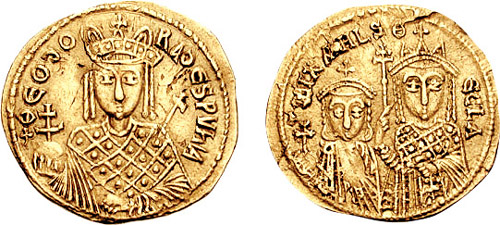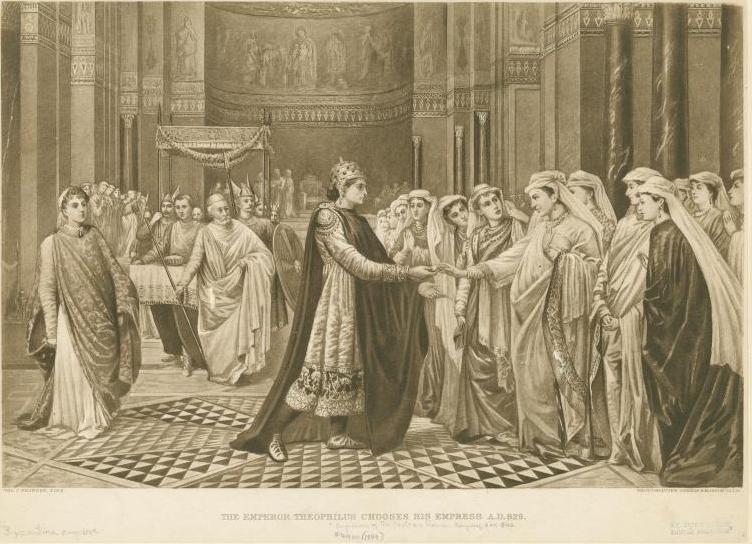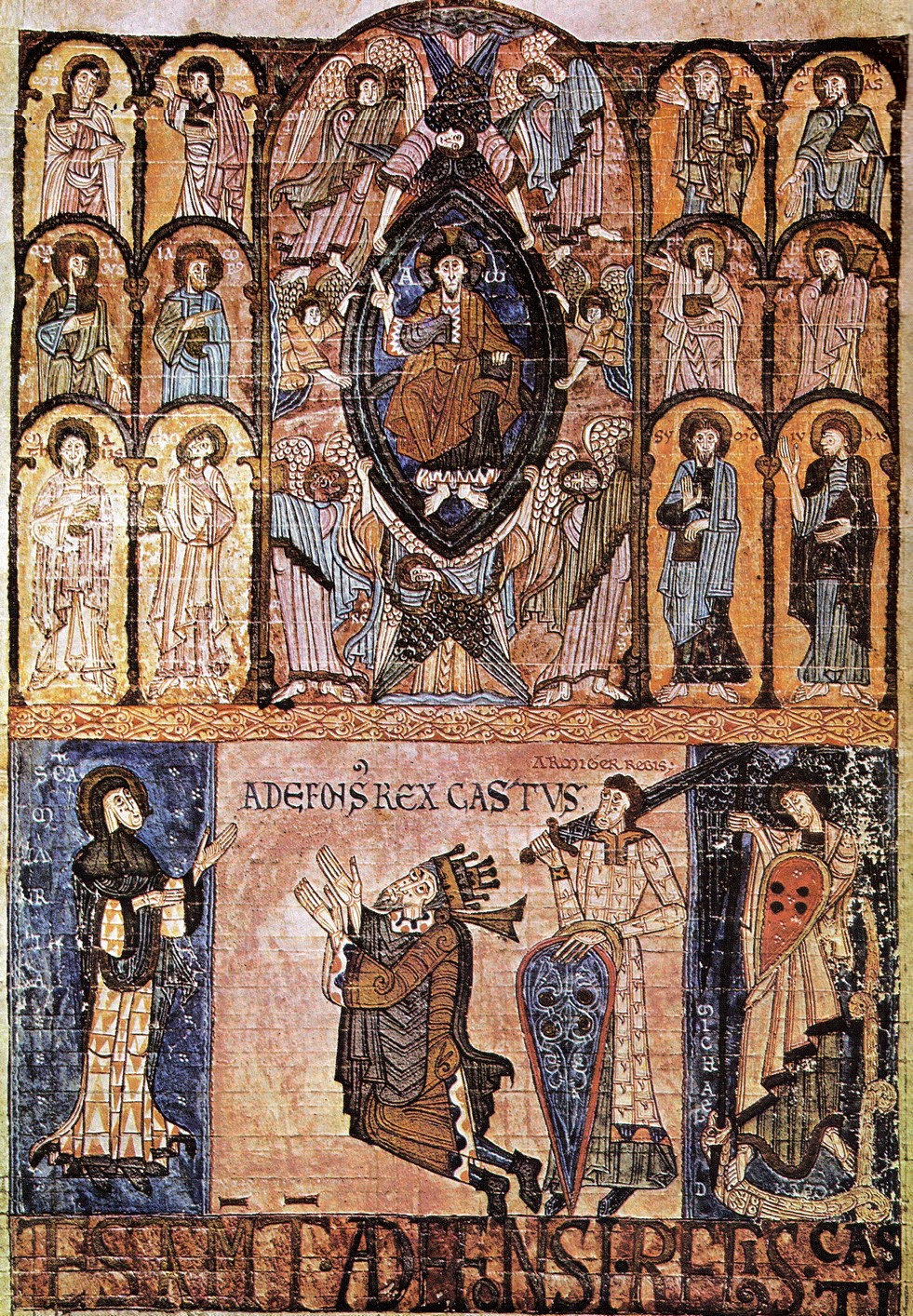|
842
__NOTOC__ Year 842 ( DCCCXLII) was a common year starting on Sunday (link will display the full calendar) of the Julian calendar. Events By place Byzantine Empire * January 20 – Emperor Theophilos dies of dysentery at Constantinople, after a 12-year reign in which he expended much effort defending the eastern frontier against the invading Muslim Arabs. Theophilos is succeeded by his 2-year-old son Michael III, with his mother Theodora as regent and the 'temporary' sole ruler of the Byzantine Empire. * February 19 – The Medieval Iconoclastic Controversy ends as a council in Constantinople formally reinstates the veneration of icons in the churches. Europe * February 14 – Oaths of Strasbourg: King Louis the German, ruler of East Francia, and his half-brother Charles the Bald, ruler of West Francia, meet with their armies at Strasbourg. They agree to swear allegiance (recorded in vernacular languages) to each other, and to support each other against th ... [...More Info...] [...Related Items...] OR: [Wikipedia] [Google] [Baidu] |
Theodora (wife Of Theophilos)
Theodora (Greek language, Greek: Θεοδώρα; 815 – c. 867), sometimes called Theodora the Armenian or Theodora the Blessed, was Byzantine empress as the wife of Byzantine emperor Theophilos (emperor), Theophilos from 830 to 842 and regent for the couple's young son Michael III, after the death of Theophilos, from 842 to 856. She is sometimes counted as an empress regnant, who actually ruled in her own right, rather than just a regent. Theodora is most famous for bringing an end to the second Byzantine Iconoclasm (814–843), an act for which she is recognized as a saint in the Eastern Orthodox Church. Though her reign saw the loss of most of Sicily and failure to retake Crete, Theodora's foreign policy was otherwise highly successful; by 856, the Byzantine Empire had gained the upper hand over both First Bulgarian Empire, Bulgaria and the Abbasid Caliphate, and the Slavs, Slavic tribes in the Peloponnese had been forced to pay tribute, all without decreasing the imperial g ... [...More Info...] [...Related Items...] OR: [Wikipedia] [Google] [Baidu] |
Theophilos (emperor)
Theophilos ( gr, Θεόφιλος; sometimes Latinized or Anglicized as Theophilus or Theophilo; c. 812 20 January 842) was the Byzantine Emperor from 829 until his death in 842. He was the second emperor of the Amorian dynasty and the last emperor to support iconoclasm.Timothy E. Gregory (2010). ''A History of Byzantium''. Blackwell Publishing Ltd. p. 227. Theophilos personally led the armies in his long war against the Arabs, beginning in 831. Life Early Theophilos was the son of the Byzantine Phrygian Greek Emperor Michael II and his wife Thekla, and the godson of Emperor Leo V the Armenian. Michael II crowned Theophilos co-emperor in 821. The date is almost universally given as 12 May 821 (Whitsunday), although this is not really corroborated by any source (another possible date is 24 March, Easter). Unlike his father, Theophilos received an extensive education from John Hylilas, the grammarian, and was a great admirer of music and art. On 2 October 829, Theophilos suc ... [...More Info...] [...Related Items...] OR: [Wikipedia] [Google] [Baidu] |
Oaths Of Strasbourg
The Oaths of Strasbourg were a military pact made on 14 February 842 by Charles the Bald and Louis the German against their older brother Lothair I, the designated heir of Louis the Pious, the successor of Charlemagne. One year later the Treaty of Verdun would be signed, with major consequences for Western Europe's geopolitical landscape. Louis the German swore his oath in Romance languages, Romance so that the soldiers of Charles the Bald could understand him. Likewise, the latter recited his in Germanic languages, Germanic so that Louis' soldiers would understand. The Romance section of the Oaths is of special importance to historical linguistics, as it is the oldest extant document in France that was written deliberately and consistently in a form of Romance languages, Romance. Context Centuries after the fall of the Western Roman Empire, Charlemagne, who had conquered much of its former territory, announced its Renovatio imperii Romanorum, restoration. Upon his death, h ... [...More Info...] [...Related Items...] OR: [Wikipedia] [Google] [Baidu] |
Michael III
Michael III ( grc-gre, Μιχαήλ; 9 January 840 – 24 September 867), also known as Michael the Drunkard, was Byzantine Emperor from 842 to 867. Michael III was the third and traditionally last member of the Amorian (or Phrygian) dynasty. He was given the disparaging epithet ''the Drunkard'' () by the hostile historians of the succeeding Macedonian dynasty, but modern historical research has rehabilitated his reputation to some extent, demonstrating the vital role his reign played in the resurgence of Byzantine power in the 9th century. He was also the youngest person to bear the imperial title, as well as the youngest to succeed as senior emperor. Life Early life and regency Michael was the youngest child of the emperor Theophilos and his empress Theodora. His precise date of birth is uncertain, but the balance of available evidence supports a birthdate in early 840, probably on 9 or 10 January. He was crowned co-emperor soon after, probably on 16 May of the same year ... [...More Info...] [...Related Items...] OR: [Wikipedia] [Google] [Baidu] |
Alfonso II Of Asturias
Alfonso II of Asturias (842), nicknamed the Chaste ( es, el Casto), was the king of Asturias during two different periods: first in the year 783 and later from 791 until his death in 842. Upon his death, Nepotian, a family member of undetermined relation, attempted to usurp the crown in place of the future Ramiro I. During his reign, which covered a span of 51 years, Alfonso discovered the supposed tomb of St. James the Great (called in Spanish) in the town of Compostela, which later became known as the city of Santiago de Compostela. He was the son of Fruela I and Munia, a Basque woman captured and brought back to Asturias by the former following a military campaign. Early life He was born in Oviedo in 759 or 760. He was put under the guardianship of his aunt Adosinda after his father's death, but one tradition relates his being put in the Monastery of San Xulián de Samos. He was the governor of the palace during the reign of Adosinda's husband Silo. On Silo's dea ... [...More Info...] [...Related Items...] OR: [Wikipedia] [Google] [Baidu] |
Byzantine Empire
The Byzantine Empire, also referred to as the Eastern Roman Empire or Byzantium, was the continuation of the Roman Empire primarily in its eastern provinces during Late Antiquity and the Middle Ages, when its capital city was Constantinople. It survived the fragmentation and fall of the Western Roman Empire in the 5th century AD and continued to exist for an additional thousand years until the fall of Constantinople to the Ottoman Empire in 1453. During most of its existence, the empire remained the most powerful economic, cultural, and military force in Europe. The terms "Byzantine Empire" and "Eastern Roman Empire" were coined after the end of the realm; its citizens continued to refer to their empire as the Roman Empire, and to themselves as Romans—a term which Greeks continued to use for themselves into Ottoman times. Although the Roman state continued and its traditions were maintained, modern historians prefer to differentiate the Byzantine Empire from Ancient Rome ... [...More Info...] [...Related Items...] OR: [Wikipedia] [Google] [Baidu] |
Louis The German
Louis the German (c. 806/810 – 28 August 876), also known as Louis II of Germany and Louis II of East Francia, was the first king of East Francia, and ruled from 843 to 876 AD. Grandson of emperor Charlemagne and the third son of Louis the Pious, emperor of Francia, and his first wife, Ermengarde of Hesbaye, he received the appellation ''Germanicus'' shortly after his death when East Francia became known as the kingdom of Germany. After protracted clashes with his father and his brothers, Louis received the East Frankish kingdom in the Treaty of Verdun (843). His attempts to conquer his half-brother Charles the Bald's West Frankish kingdom in 858–59 were unsuccessful. The 860s were marked by a severe crisis, with the East Frankish rebellions of the sons, as well as struggles to maintain supremacy over his realm. In the Treaty of Meerssen he acquired Lotharingia for the East Frankish kingdom in 870. On the other hand, he tried and failed to claim both the title of Emperor ... [...More Info...] [...Related Items...] OR: [Wikipedia] [Google] [Baidu] |
January 20
Events Pre-1600 * 250 – Pope Fabian is martyred during the Decian persecution. * 649 – King Chindasuinth, at the urging of bishop Braulio of Zaragoza, crowns his son Recceswinth as co-ruler of the Visigothic Kingdom. * 1156 – Finnish peasant Lalli kills English clergyman Henry, the Bishop of Turku, on the ice of Lake Köyliö. * 1265 – The first English parliament to include not only Lords but also representatives of the major towns holds its first meeting in the Palace of Westminster, now commonly known as the "Houses of Parliament". * 1320 – Duke Wladyslaw Lokietek becomes king of Poland. * 1356 – Edward Balliol surrenders his claim to the Scottish throne to Edward III in exchange for an English pension. * 1523 – Christian II is forced to abdicate as King of Denmark and Norway. * 1567 – Battle of Rio de Janeiro: Portuguese forces under the command of Estácio de Sá definitively drive the French out of Rio de Janeiro. * 157 ... [...More Info...] [...Related Items...] OR: [Wikipedia] [Google] [Baidu] |
March 20
Events Pre-1600 * 673 – Emperor Emperor Tenmu, Tenmu of Japan assumes the Chrysanthemum Throne at the Asuka, Yamato#Imperial Palaces, Palace of Kiyomihara in Asuka, Yamato, Asuka. *1206 – Michael IV of Constantinople, Michael IV Autoreianos is appointed Ecumenical Patriarch of Constantinople. *1600 – The Linköping Bloodbath takes place on Maundy Thursday in Linköping, Sweden: five Swedish noblemen are public execution, publicly beheaded in the aftermath of the War against Sigismund (1598–1599). 1601–1900 *1602 – The Dutch East India Company is established. *1616 – Sir Walter Raleigh is freed from the Tower of London after 13 years of imprisonment. *1760 – The Great Boston Fire of 1760 destroys 349 buildings. *1815 – After escaping from Elba, Napoleon enters Paris with a regular army of 140,000 and a volunteer force of around 200,000, beginning his "Hundred Days" rule. *1848 – German revolutions of 1848–49: Monarch, King Lu ... [...More Info...] [...Related Items...] OR: [Wikipedia] [Google] [Baidu] |
February 14
Events Pre-1600 * 748 – Abbasid Revolution: The Hashimi rebels under Abu Muslim Khorasani take Merv, capital of the Umayyad province Khorasan, marking the consolidation of the Abbasid revolt. * 842 – Charles the Bald and Louis the German swear the Oaths of Strasbourg in the French and German languages. * 1014 – Pope Benedict VIII crowns Henry of Bavaria, King of Germany and of Italy, as Holy Roman Emperor. * 1130 – The troubled 1130 papal election exposes a rift within the College of Cardinals. * 1349 – Several hundred Jews are burned to death by mobs while the remaining Jews are forcibly removed from Strasbourg. * 1530 – Spanish conquistadores, led by Nuño de Guzmán, overthrow and execute Tangaxuan II, the last independent monarch of the Tarascan state in present-day central Mexico. * 1556 – Having been declared a heretic and laicized by Pope Paul IV on 4 December 1555, Archbishop of Canterbury Thomas Cranmer is publicly de ... [...More Info...] [...Related Items...] OR: [Wikipedia] [Google] [Baidu] |
Strasbourg
Strasbourg (, , ; german: Straßburg ; gsw, label=Bas Rhin Alsatian, Strossburi , gsw, label=Haut Rhin Alsatian, Strossburig ) is the prefecture and largest city of the Grand Est region of eastern France and the official seat of the European Parliament. Located at the border with Germany in the historic region of Alsace, it is the prefecture of the Bas-Rhin department. In 2019, the city proper had 287,228 inhabitants and both the Eurométropole de Strasbourg (Greater Strasbourg) and the Arrondissement of Strasbourg had 505,272 inhabitants. Strasbourg's metropolitan area had a population of 846,450 in 2018, making it the eighth-largest metro area in France and home to 14% of the Grand Est region's inhabitants. The transnational Eurodistrict Strasbourg-Ortenau had a population of 958,421 inhabitants. Strasbourg is one of the ''de facto'' four main capitals of the European Union (alongside Brussels, Luxembourg and Frankfurt), as it is the seat of several European insti ... [...More Info...] [...Related Items...] OR: [Wikipedia] [Google] [Baidu] |
Iconoclastic Controversy
The Byzantine Iconoclasm ( gr, Εικονομαχία, Eikonomachía, lit=image struggle', 'war on icons) were two periods in the history of the Byzantine Empire when the use of religious images or icons was opposed by religious and imperial authorities within the Orthodox Church and the temporal imperial hierarchy. The First Iconoclasm, as it is sometimes called, occurred between about 726 and 787, while the Second Iconoclasm occurred between 814 and 842. According to the traditional view, Byzantine Iconoclasm was started by a ban on religious images promulgated by the Byzantine Emperor Leo III the Isaurian, and continued under his successors. It was accompanied by widespread destruction of religious images and persecution of supporters of the veneration of images. The Papacy remained firmly in support of the use of religious images throughout the period, and the whole episode widened the growing divergence between the Byzantine and Carolingian traditions in what was still a u ... [...More Info...] [...Related Items...] OR: [Wikipedia] [Google] [Baidu] |







